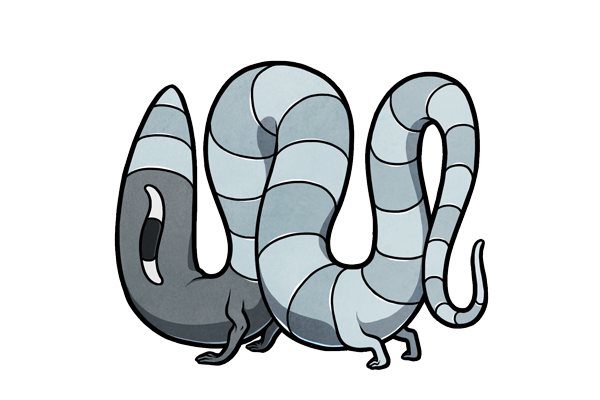

turitrone
the gamboliers
prefix turi suffix trone
doremi olida
physical appearance
The turitrone /ˈtʊɹˌtɹəʊn/ is a teal, small-limbed stranger that holds its torso and tail in a series of rising curves. Its body is hollow, with a mesh-like layer of fibers just beneath the skin. This interlocking capillary structure keeps the stranger's form rigid, but flexible. Though it is firm enough to maintain the tube-like shape of the turitrone's undulating body, neither this internal trellis nor the turitrone's thin and papery skin are particularly durable, and smaller individuals can be crumpled up or ripped apart with ease.
The strain is also notable for its significant size variance. Some individuals are small enough to be held in the hand, while others are taller than a person in height. In the face of violence, the turitrone voluntarily breaks down.
When vocalizing, the turitrone sounds like a human being, though with horn-like distortions present. Each turitrone possesses a range of voices, though it speaks only rarely.
Da-da, doot, doot, deedle-dah!

environment and generation
The turitrone in places where a parade or other celebration has occurred, with more recent cavalcades spawning turitrone in greater abundance. The strain's generation seems further spurred by the presence of neon signs, technicolor billboards, and other patches of vivacious advertisement.
It generates on empty stretches of flat ground large enough to contain its form without obstruction, appearing first as a crumpled mass (this sheet lacking the strain's characteristic internal trellis), which inflates as the filaments of its body grow and thicken. The turitrone reaches full size by the end of an hour's passing. It most often generates in the early morning hours, and preferably before dawn.
Groups of turitrone develop in a line, with no less than two full body lengths between each individual, and no more than three.
behaviour
The turitrone expresses a reticent, yet celebratory nature. As it moves, it dances, with individual turitrone marching forward at a varying, yet self-consistent pace.𐊷 Though lively, the turitrone's range of actions is limited; it can step forward and back, rotate its body, gyrate its midsection, and little else. It tends to travel in straight lines down whatever long passageways and corridors that it can find, rotating upon reaching a dead end. Otherwise, its march follows no course.
𐊷
80 BPM "slow-time"
90 BPM "rag-step"
100 BPM "brevo-step"
110 BPM "hot pace"
120 BPM "state rank"
130 BPM "frenzied"
Groups of turitrone stick together, usually moving in a linear procession, and arranging themselves into triangular or two-lane arrays only in very wide-open areas. The turitrone adjusts its walking rhythm to match the leader of the line (with small individuals moving at double or quadruple the pace of a larger leader, and large followers moving at half- or quarter-speed to match a small leader, for example.) Each individual follows the closest possible turitrone, and does not trail a turitrone already accompanied by a follower.
The turitrone relies on visual cues to maintain formation. As such, a line of turitrone may become caught in an endless ring when the leader inadvertently loops around to follow the hindmost individual; once this occurs, the group struts in a perpetual circle until disrupted.
interactions with sensitives
The turitrone is attracted to sensitives. Though it does not pursue direct physical contact, it appears to adjust its path around and in front of a sensitive, as though putting on a show for them.
A sensitive who moves in time with the turitrone's movements causes the stranger's own motions to grow more involved, in turn. Should a sensitive increase the complexity of their own gestures, so too can further layers of actions be introduced to the turitrone. The stranger may begin to sway its head from side to side, wag its tail in curling loops, or raise its midsection in swells bordering on the dramatic. As the turitrone's behaviour reaches a heightened state of intricacy, its singing state is finally unlocked. Once the turitrone starts to sing, each new level of movement brings with it a new voice, with up to five overlapping voices being present at once.
As soon as the sensitive moves away briskly from the turitrone, however, the stranger loses interest, and returns to its usual routine. Thus, though simple in theory, it can prove difficult to engage with a turitrone and elicit its "dance". Even the slightest misstep or pause causes the turitrone to cease its mimicry, if not break down altogether. A routine ability to elicit all five of the turitrone's voices might be considered preternatural. Regardless of the outcome, any engagement with the turitrone's dance does decrease the stranger's lifespan. Though more complex dances diminish the turitrone's longevity at an exponential rate, any attempt to mirror the turitrone brings some diminishment of lifespan.
Encountering the turitrone brings, at first, a vigorous improvement in health and vigor for up to two weeks following the encounter. Self-esteem is boosted, unflagging energy become the norm, and any ongoing health problems become less noticeable. This gain in stamina, however, is only temporary, stopping just as abruptly as it began, and with some fatigue and balance issues continuing for half as many days as the vigor lasted. Should an individual successfully evoke the turitrone's full dance, however, such energy and assurance remains for up to one year, with only a gradual drop-off in strength, and no negative repercussions.
aging and death
As the turitrone ages, it becomes unfocused. It no longer marches with confidence, but instead holds its body up in ever-more-precarious sways. Towards the final quarter of its life, it stumbles over nonexistent obstacles and wanders into dead ends with increasing frequency. It also loses its attraction to sensitives, becoming less able to go into its full "dance".
Eventually, the turitrone succumbs to its demise, drooping down upon the earth below, and deflating once grounded. It cycles through its range of movements (as best it can from this prostrate position) as the other turitrone in the parade step over its body, sometimes crumpling their fallen companion in the process (or causing them to tumble, in turn). A fallen turitrone's inner trellis fades to a translucent color then dissolves to nothing, and the stranger dies.
The turitrone's corpse grows more flimsy by the day, its skin crumbling apart into papery fragments, until it is nothing more than a pile of fibers and small scraps. Its remains are scattered underfoot, or on the wind, indistinguishable from the confetti and streamers in the wake of a parade, and drawing no concern from the promenades that follow.



